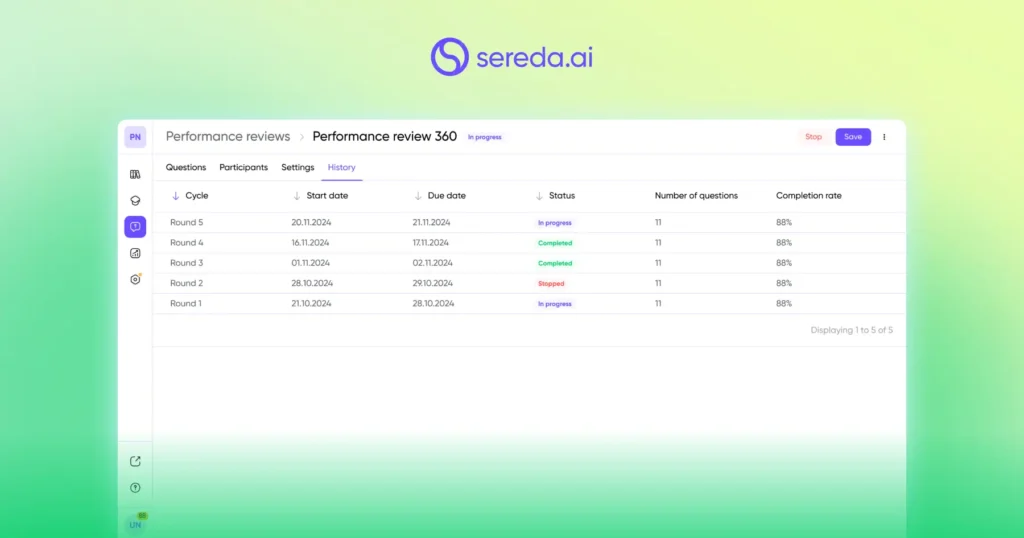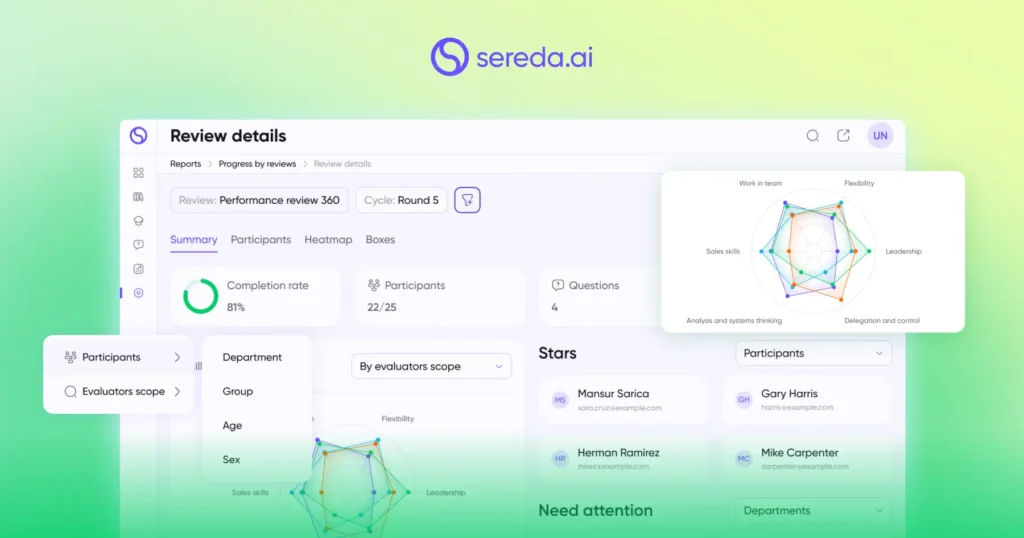Traditional performance reviews often miss the bigger picture. They focus on top-down feedback, leaving out valuable insights from peers, subordinates, and even the employees themselves. That’s where 360-degree feedback comes in.
In this article, the Sereda.ai team breaks down what 360-degree feedback is, why it matters, and how to use it effectively — whether you’re an employee looking to grow or a company aiming to build a high-performing team.
What Are 360 Reviews
This is a commonly used, effective way to assess workers from multiple perspectives, hence the name 360-degree review. It provides constructive, confidential, personalized feedback about employees, offering a full picture of their strengths and weaknesses.
360-degree feedback vs. standard performance review
The key difference between the two lies in the goal:
- 360-degree feedback is all about employee development and identifying the areas for growth;
- On the other hand, the standard performance review is a tool for recognizing achievements and often results in rewards (promotion, salary raise, etc.).
Used as a unit, these assessments will create a balanced approach to employee review management.
Benefits of the 360 review process
The 360 review process is so popular for a list of specific reasons. Let’s take a closer look at 4 ways employee feedback will change your company for the better:
- Identifying future leaders: 360 review is a great opportunity to recognize employees with high potential. This, in turn, helps to develop and tailor leadership programs for the potential team leads.
- Growing together: Reviews and constructive feedback make employees feel seen. So, when there is an understanding that the company evaluates, cares, and is ready to help – the staff’s commitment to the organization increases.
- Building strong units: Timely feedback and honest personal reviews create a certain transparency in teams. As a result, this honesty fosters stronger bonds between members and increases productivity.
- Presents real data: Finally, 360 reviews are common among companies because they provide management with real data. Accurate statistics are always crucial for confident decision-making.
Key Steps for Implementing 360-Degree Feedback
Now that we covered the basics, the next sections will be fully dedicated to exploring the 3 key steps of conducting an effective employee feedback process. Let’s begin!
Step 1. Pre-planning
A 360 review is a lengthy procedure that takes time and requires some concrete preparations. Here’s what you need to do before launching your evaluations:
1.1 Choose participants
Who is going to assess whom? You need to choose which employees will be evaluated. Then, identify the key colleagues, managers, and subordinates who will provide feedback on them.
This clear planning will help you to distribute questionnaires quickly and receive the most accurate results.
1.2 Set clear objectives
Why are we doing this? Before launching the 360 review, define a clear purpose for the evaluation. There are different goals for employee reviews, but the most common are:
- Leadership development;
- Skill enhancement;
- Improving in-team relationships.
1.3 Establish evaluation criteria
What are we measuring? Similar to the previous point, you need to know what competencies you want to access. The key skills that are usually measured are:
- Communication;
- Leadership;
- Problem-solving.
1.4 Ensure confidentiality and psychological safety
Will participants feel safe and ready to answer honestly? While creating a questionnaire, keep in mind that some team members may feel uncomfortable or pressured to answer in a certain way. Here, the main advice is to communicate that this evaluation is for improvement and growth only.
Step 2. Launching the 360 Degree Feedback Process
As soon, as your pre-planning is done, it’s time to begin the 360 review process:
2.1 Choose your tools
The correct tools are crucial for multistep evaluations like 360-degree feedback. There is an array of specialized platforms to choose from, so keep in mind your assessment criteria and goals while picking the right tool.
Some general features to look for in a platform include:
- Ability to customize;
- Anonymity (that you can control);
- Advanced analytics that will give you food for thought;
- Data visualization features.
2.2 Train reviewers for constructive and unbiased feedback
Guide reviewers through the assessment process: explain to them that the feedback should be constructive and actionable. Here you can prepare small guidelines for the reviewers or create a coaching session that will explain the evaluation system and will help them through the procedure.
2.3 Design targeted questionnaires
The questionnaire is the main character of this show. Here are a few actionable tips on how to create effective questions that will later provide you with valuable insights:
- Make your questions clear and specific, do not leave an opportunity for misinterpretation;
- If you want direct and structured answers, use the Likert scale questions (1-5 ratings);
- For deeper insights, ask open-ended questions;
- Be mindful of the reviewer’s roles – customize your questions based on seniority and job functions. For example, platforms like Sereda.ai include pre-made templates for different reviewers: managers, teammates, colleagues, etc.
2.4 Set timelines to avoid delays
As with every task – setting deadlines is the key. Here, try to establish a specific time frame for reviewers to complete your questionnaires and consider different periods depending on the reviewer’s role and workload.

Step 3. Analyzing Results
After the successful completion of 360-degree feedback, we are moving on to analyzing the responses. Here are the main things that you need to do at this stage of the assessment:
3.1 Identifying patterns
Advanced performance evaluation platforms are great at showcasing the patterns. So utilize their built-in analytics tools to identify strengths, weaknesses, and other criteria that you established in pre-planning.
3.2 Handling conflicting feedback
Responses can contradict each other, depending on the role of the responders. It’s only natural that managers might have a slightly different view of employee skills than their peers. While patterns will hold priority, treat those contradictions as an opportunity to gain a bigger picture: ask follow-up questions, send additional surveys, or just consider that some of the responders may be biased.
3.3 Developing actionable insights
Of course, the true meaning behind a 360 review is to get information and take action. Consider all the responses that you received and develop a roadmap of what can be improved.

Mastering 360-degree Reviews with Sereda.ai
Creating employee reviews without the right tool – is a recipe for the wrong results and too much additional hustle. Here at Sereda.ai, we use the power of AI to make your employee evaluation and development so much easier.
Here’s how our platform can help:
- Flexible review options: from 90 to 360-degree feedback – conduct a variety of employee reviews with ease.
- Heatmaps: with our tool, you can spot performance strengths and gaps at a glance with intuitive heatmaps.
- Tracking performance dynamics over time: with Sereda.ai, you can perform multiple evaluation cycles and compare data from different time frames.
- Competency builder for targeted development: we offer you ready-made competency model templates, developed by professional methodologists.
- BI Analytics: easily spot employee strengths and areas for improvement with our detailed BI report.
Conclusion
A 360 review isn’t just an HR process – it’s a powerful tool for growth. It enhances self-awareness, strengthens leadership, and drives high-performing teams. Sereda.ai is a modern, cutting-edge solution designed to make performance management smarter and more effective.
Ready to elevate your team’s potential? Book a demo today and see Sereda.ai in action!